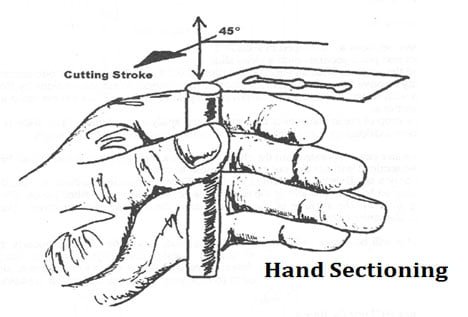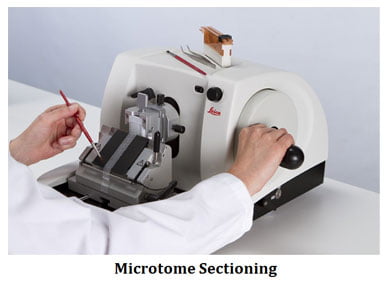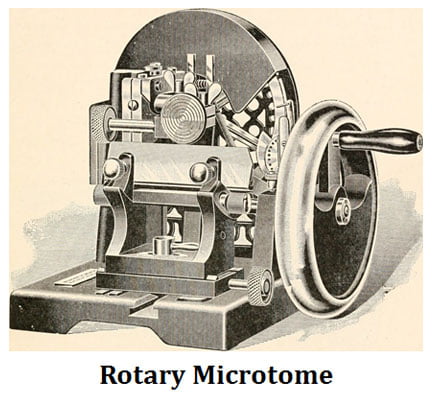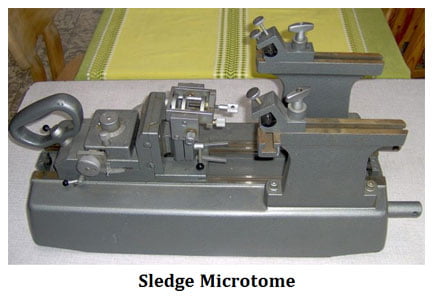Sectioning in biology refers to the process of cutting a sample of tissue or an organism into thin sections for examination under a microscope. The process is used to study the structure and composition of biological specimens, including tissues, organs, and cells. Sectioning can be done by freehand sectioning or with microtome (Microtomy). The present post discusses the techniques of Freehand and Microtome Sectioning.
Learning objectives: What is sectioning? Importance of sectioning, Different type of sectioning; Hand sectioning (Merits & Demerits); Serial sectioning (Merits & Demerits); Instrument of serial sectioning: Microtome & Microtomy; Different types of microtomes; Advantages of microtome sectioning; Limitations of microtome sectioning
Why we need sectioning in histology/Anatomy?
Ø For understanding the internal structure of tissues.
Ø For the study of the arrangement of cells.
Ø Important in Histology (the study of tissues)
Ø Two types of sectioning in microtechnique:
(1). Free-hand sectioning
(2). Sectioning with a cutting device (microtome)
(1). Free hand sectioning
Ø Sectioning done by the free-hand with a knife or blade is called free hand-sectioning.
Ø Hold the specimen in one hand and cut the specimen using a razor blade or knife.
Ø Should take large number of sections and have to select one complete, thin and even section for downstream processing (staining or dehydration).
Ø Delicate materials should be supported to withstand the cutting force.
Ø Pith can be used for supporting the delicate materials.

Advantages of free-hand sectioning
Ø Easy to practice
Ø No sophisticated instrumentations required for free-hand sectioning
Limitations of free-hand sectioning
Ø Skill is required to take good section.
Ø Extremely small materials cannot be sectioned by free-hand sectioning.
Ø Sections may not have a uniform thickness.
Ø Sections may be too thick.
Ø Sections less than 10 microns cannot be obtained by free-hand sectioning.
Ø Serial sectioning is not possible with free-hand sectioning.
(2). Sectioning with a cutting device (microtome)
Ø Microtome: The device used to take ultra-thin sections (less than 10 microns) is called microtome.
Ø Greek: mikros = small, tome = cutting
Ø Microtomy: The sectioning with microtome is called microtomy.
Ø Example: Ultra-thin sectioning for electron microscopy (TEM)

how to section with microtome
Parts of a microtome
Ø A microtome contains the following parts:
$. Part to hold the specimen
$. Part to hold the knife/blade
$. Provision for movement of knife/specimen
$. Provision of adjustment of section ticking
S. Provision for the serial sectioning
There are two broad categories of microtomes:
(1). Sledge microtome: Specimen remains stationary, knife moves.
(2). Rotary microtome: Knife remains stationary, specimen moves
 Rotary microtome
Rotary microtome
Ø The knife remains stationary, specimen moves up and down.
Ø It consists of a large wheel with provision for rotation.
Ø Wheel rotation causes the specimen block to move up and down.
Ø Each movement pushes the specimen forward to a fixed distance.
Ø This pushing distance is the thickness of the section.
Ø Provision for serial sectioning is also available in the rotary microtome.
Special types of microtomes
Ø Ultra-microtome: Microtome for taking sections for electron microscopy.
Ø Cryomicrotome (cryotome): Microtome for taking sections of specimen embedded in ice blocks.

Advantages of microtome/microtomy
Ø Extremely small materials can be sectioned with a microtome.
Ø Sections will have a uniform thickness.
Ø Ultra-thin sections can be obtained.
Ø Serial sectioning is possible with microtome sectioning.
Limitations of microtome/Microtomy
Ø High instrumentation charge is involved in microtomy.
Ø Tedious preparatory steps required before the sectioning.
Ø Specimens should be embedded in the embedding medium (paraffin, plastic) before the sectioning.
Ø Downstream processing after the sectioning is also tedious.
<<< Back to MICROTECHNIQUE Notes
You might also like…
@. Dehydration and Clearing + PPT
